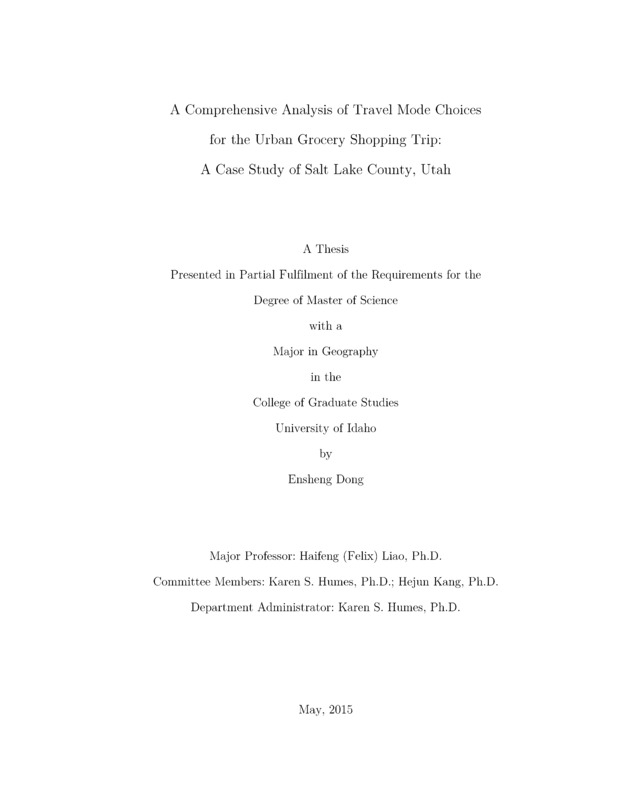A Comprehensive Analysis of Travel Mode Choices for the Urban Grocery Shopping Trip: A Case Study of Salt Lake County, Utah
Dong, Ensheng. (2015). A Comprehensive Analysis of Travel Mode Choices for the Urban Grocery Shopping Trip: A Case Study of Salt Lake County, Utah. Theses and Dissertations Collection, University of Idaho Library Digital Collections. https://www.lib.uidaho.edu/digital/etd/items/dong_idaho_0089n_10622.html
- Title:
- A Comprehensive Analysis of Travel Mode Choices for the Urban Grocery Shopping Trip: A Case Study of Salt Lake County, Utah
- Author:
- Dong, Ensheng
- Date:
- 2015
- Keywords:
- Geographical Scale Multinomial Logit Models (MNL) Salt Lake County Travel Mode Choices Urban Grocery Shopping Trip
- Program:
- Geography
- Subject Category:
- Geography; Transportation planning; Geographic information science and geodesy
- Abstract:
-
This research comprehensively investigates influential factors which govern people’s choices concerning which travel mode they use for shopping trips. The data about 1,294 home-based shopping trips was collected from the 2012 Utah Travel Survey. 61.75% of the respondents drove alone to their grocery stores, whereas 32.46% selected carpooling and the rest chose other modes. A descriptive analysis and multinomial logit models (MNL) were conducted to estimate the impact of individual socioeconomic characteristics, accessibility variables, and household and store built-environments on mode choices during shopping trips. The characteristics of built-environments in the neighborhoods around households and stores were measured while taking spatial scales into account. Results show that strong predictors of walking or riding public transit to the grocery store were age, household composition (the number of household members), vehicle ownership, household annual income, land use mix, street density, and distance to the central business district. Results also suggest that different factors have different optimal geographical scales for studying shopping trip travel modes. The straight-line buffer is good for the sales amount, the network buffer is suitable for the household built-environment factors, and the census block and block group scales apt for the store built-environment factors. Future studies of the travel mode choice for urban grocery shopping trips should consider the effect of spatial scales on built-environment factors and also additional store characteristics, such as the number of employees, the number of parking lots, and the variety of shops.
- Description:
- masters, M.S., Geography -- University of Idaho - College of Graduate Studies, 2015
- Major Professor:
- Liao, Haifeng
- Committee:
- Humes, Karen S; Kang, Hejun
- Defense Date:
- 2015
- Identifier:
- Dong_idaho_0089N_10622
- Type:
- Text
- Format Original:
- Format:
- application/pdf
- Rights:
- In Copyright - Educational Use Permitted. For more information, please contact University of Idaho Library Special Collections and Archives Department at libspec@uidaho.edu.
- Standardized Rights:
- http://rightsstatements.org/vocab/InC-EDU/1.0/

